#Museum of Contemporary Craft
Explore tagged Tumblr posts
Text

Preston Singletary Raven Steals the Moon, 2001 Glass Lifeforms, Fuller Craft Museum Photo taken by Emerson Please do look up other examples of Preston Singletary's work, really detailed and beautiful. Example of more here: https://www.travergallery.com/artists/preston-singletary/
#preston singletary#glass artist#glass sculpture#glass art#glass lifeforms#fuller craft museum#native american glass artist#tlingit art#native american heritage month#contemporary art
41 notes
·
View notes
Text

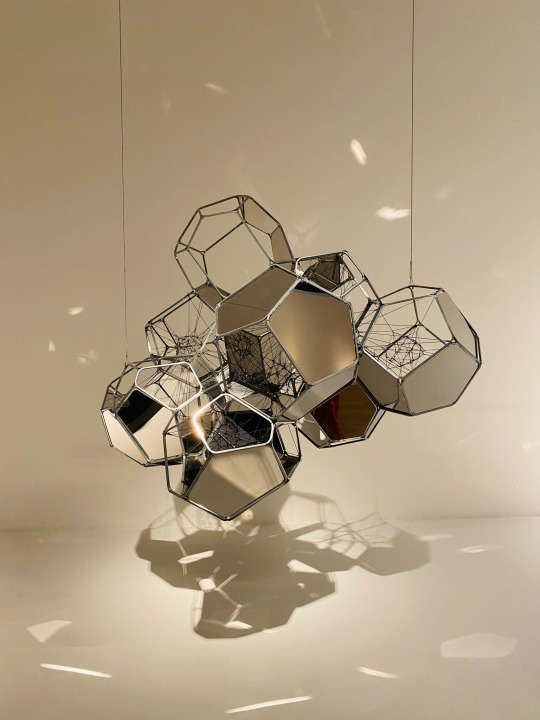


Malba. Marzo 2023
#photography#argentina#photo#colours#photoshoot#art#museum#contemporary#sculpture#buenos aires#malba#arts and crafts#beautiful#trendy#artists on tumblr
10 notes
·
View notes
Text
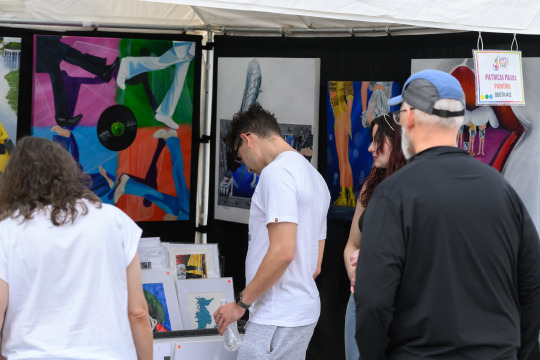
#CallToArtists --> All artists are invited to apply for the 26th Annual Art & Music Festival in the Pines, a FREE two-day art and music celebration in the City of Pembroke Pines, held at the Charles F. Dodge City Center, 601 City Center Way, from Saturday, November 2nd, 2024 (11am to 6pm) and Sunday, November 3rd, 2024 (12pm to 5pm). This event is free to the public and will feature talented artists from all over the country, live music, food trucks, workshops at The Frank Pembroke Pines Art Gallery, a Student Art Competition, Kids’ Art & Game Zone, performances, live hands-on art demonstrations and much more! The City of Pembroke Pines invites all artists and crafters to apply to the 26th Annual Art & Music Fest in the Pines. Applications are available through ZAPP until October 21st, 2024. Interested parties are encouraged to apply! SEE LINK TO APPLY.
#art#arte#miamiartscene#miami#artlovers#curators#design#illustration#museums#call to artists#art call#call for artists#call for entry#painters#art festival#visual artists#contemporary art#arte contemporanea#south florida#art event#sculptor#photography#ceramic art#crafts#visual arts
0 notes
Text
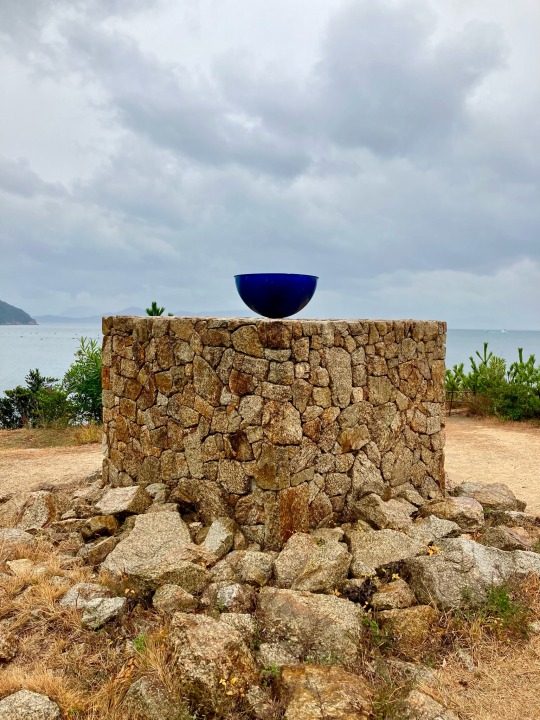
Photo by: matchart.tumblr.com
#public art#art in nature#original phography#photographers on tumblr#naoshima#japan#art#contemporary art#sea#island#craft#museum#直島#アート#美術
0 notes
Text
Margit Jäschke – Kairos: Hamburg vom 29.11.2023 bis 28.04.2024
Das rund 30-jährige Schaffen der vielfach ausgezeichneten Künstlerin Margit Jäschke (* 1962) ist in der zweiten Ausstellung der 2022 initiierten Reihe „Contemporary Craft“ im MK&G zu sehen. Margit Jäschke bezeichnet sich selbst als Wanderin zwischen den Kunstwelten: Jenseits der Grenzen von Schmuck, Installation, Malerei und Skulptur hat sie ein ganz eigenständiges Werk realisiert. Dabei…
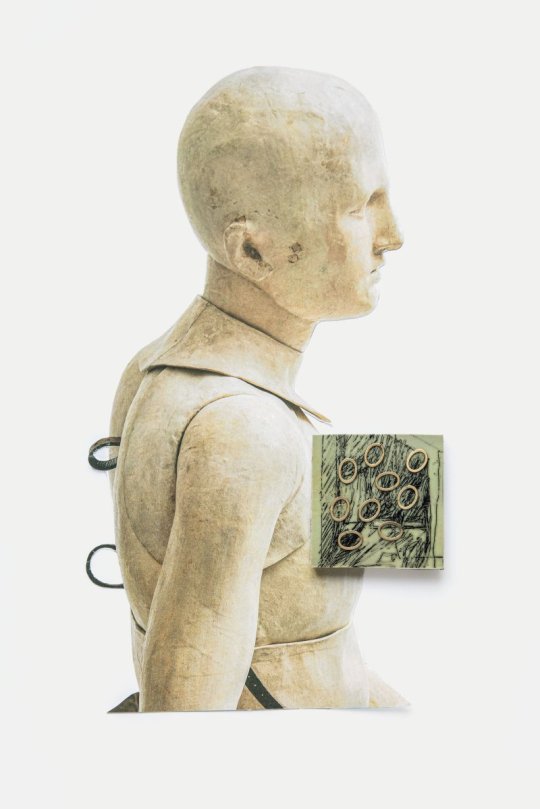
View On WordPress
#angewandte Kunst#Collage#contemporary craft#Hamburg#Inspiration#Installation#KAiros#Malerei#Margit Jäschke#mk&gmesse#Museum für Kunst & Gewerbe#Schmuck#Schmuckkunst#Skulptur#Unikatschmuck
0 notes
Text

'your best kitchen mate!' by maarten baas, 2004 in against the grain: wood in contemporary art, craft + design - museum of arts and design (2012)
1K notes
·
View notes
Text

A BRAND NEW SIMS 3 WORLD : SHETLAND HARBOUR
And here we are ... At last :D
10 years ago, Rope crafted a remarkable world, inspired by Starlight Shores, and generously given away to the community : Brightwater.
We embraced this gift, transforming and reshaping it, creating an island to eliminate distant terrain, and thus, Shetland Harbour was born ...
While many creators have fashioned stunning Sims 3 worlds with a Northern charm—like Saaqartoq, Greymont Bay, Lillebror, or Plymouth Isles—ours, stands a little apart.
Shetland Harbour is a unique blend : a touch of Aurora Skies, a hint of Moonlight Falls, and a dash of the unfortunate Barnacle Bay, all interwoven with our own vision of course. It is a vast yet easily navigable world, balanced between lightness and richness, featuring nearly all the Rabbit Holes the game offers.
Our aim was to craft a cohesive and vibrant world, one that feels alive and contemporary, with harmonious architecture and a spirit that invites exploration and delight :)
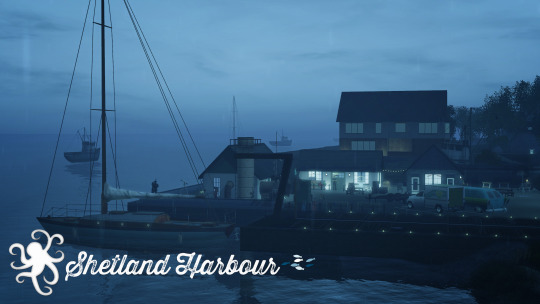
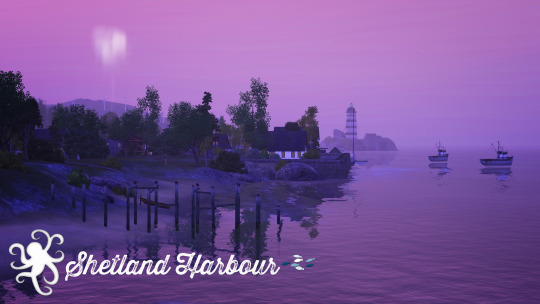

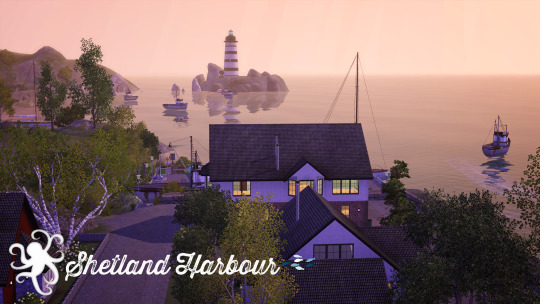
Welcome to Shetland Harbour, a picturesque coastal town nestled between rolling green hills and a fantastic bay … It is a beautiful medium/large-sized world, a community nestled on its own secluded island, accessible only by ferry. The town is known for its charming cobblestone streets, a vibrant fish market, and a rich history dating back centuries, dotted with quaint cottages, a bustling coast, and a grand lighthouse standing guard at the harbor’s entrance ...
This hidden gem is a haven for sheep, but don't let that fool you – Shetland Harbour is far from a sleepy place. With its rich maritime history, the town offers a unique blend of tradition and vibrant local culture.
Designed to capture the essence of a northern European island, Shetland Harbour offers a self-contained community with 100 lots in total : 65 residential lots + 35 community lots. Each Lot ( except the Old Renovated Factory ) is fully furnished.
In addition, there are multiple sheep ( all by Murfeel ) fields here and there – the latter being especially dear to the local culture, a close-knit community, where the ocean's presence is always felt and the simplicity of rural life is celebrated.
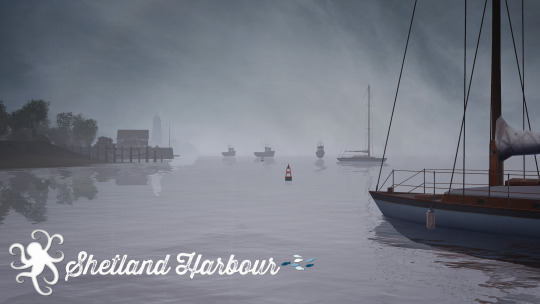

Shetland Harbour combines a lively downtown with peaceful suburbs and serene neighborhoods, featuring quaint cottages, charming gardens, and scenic paths through lush greenery.
The town's historic churches, like Old Church, Albert Church or Lux Chapel, are steeped in tales of ancient rituals and ghostly apparitions ... Albert Church, built on a Druidic site, is haunted by druid spirits, while Lux Chapel is known for the ghost of a sailor, seen on stormy nights ...
The mysterious stone circle inside the Graveyard, Ghost Place, adds to the island's mystical allure. Rumored to be a portal to another realm, it activates during celestial alignments, with visitors reporting strange occurrences. Town elders speak of a prophecy foretelling the return of ancient spirits and the awakening of the island's mystical powers. Signs include a rare star alignment, the stone circle's awakening, and three chosen individuals with the island's ancient bloodline ...
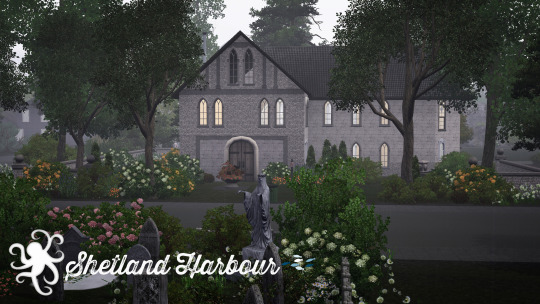
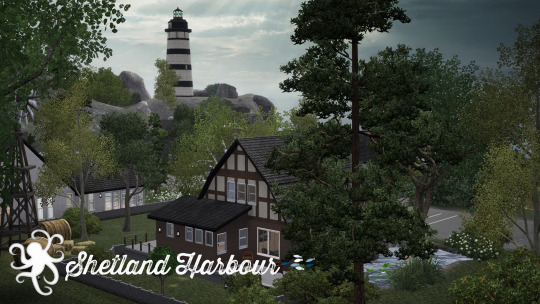






• Harbor Bay : The central feature of Shetland Harbour is its expansive bay. The bay is a natural harbor with calm, crystal-clear waters, making it ideal for fishing and sailing. It is surrounded by gently sloping hills and cliffs that provide stunning vistas of the sea. The marina is bustling with fishing boats, sailboats, and yachts sometimes … It’s the hub of maritime activity, with a fish market ( aka Grocery Store ), boat repairs, and a sailing club ( aka Business and Journalism Center )
• Lighthouse District : Right beside the Harbour, stands the Lighthouse Point, this district features historical homes and buildings, including a Norman cottage, a strange Diner and higher into the Hills, a fantastic museum dedicated to the town’s maritime history and a recent Hospital ready to welcome all the citizens of Shetland Harbour :)
• Beaches : The Coastline is dotted with sandy beaches, perfect for beachcombing, picnics, and bonfires. These areas are popular spots for locals and tourists alike. And you may want building some Coastal Houses for your Sims which is possible almost all alongside the sea ;)
• Old Town : The heart of Shetland Harbour is the Old Town, characterized by cobblestone streets, historic buildings, and a charming town square. Shetland Harbour's downtown area is a kinda picturesque pedestrian square, and quaint paths perfect for leisurely strolls …The Old Town includes the Town Hall, the Old Toad, the Talking Dog, a Fish and Chips, and even a Geek Store, all of them under the shadow of one of the oldest shop of the Island : the Elixirium ...
• Rolling Hills : Surrounding the town are rolling green hills covered in wildflowers and dotted with grazing sheep. These hills are perfect for hiking and offer panoramic views of the town and the bay. Beware of the fog !
• Forests and Woodlands : To the north of the town are more dense forests and woodlands with waterfalls upstream of the river which separates part of the island. These areas are home to various wildlife and provide a natural retreat for the residents. There are several well-maintained trails for hiking and exploring :)
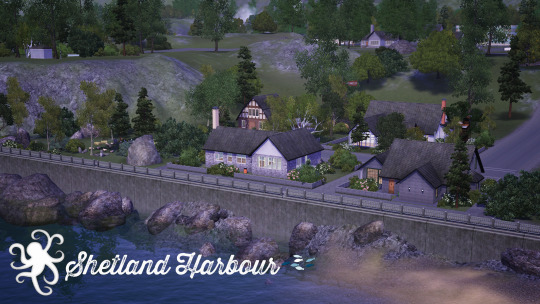



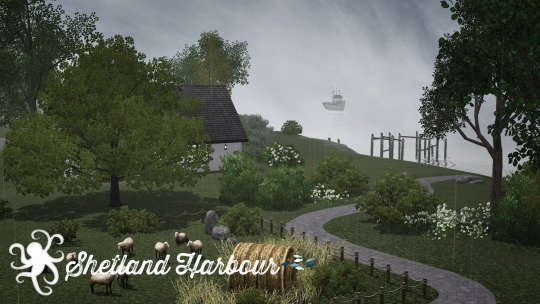


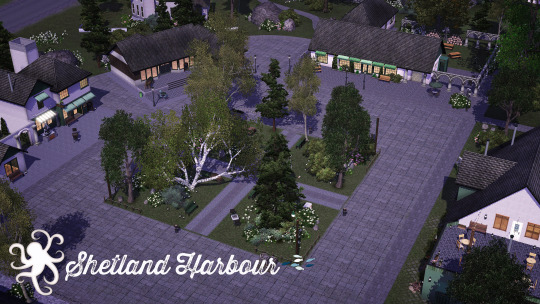
Come and explore Shetland Harbour all your content ... Whether you're building your dream home, running a local business, or simply soaking in the serene atmosphere, this unique town promises endless possibilities and a truly captivating experience ...


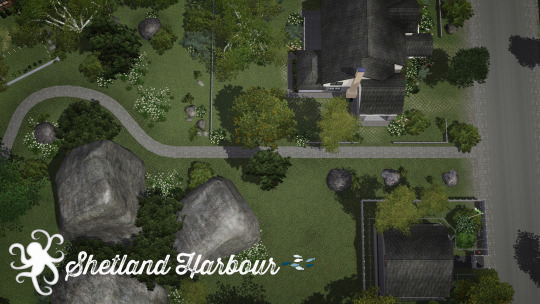
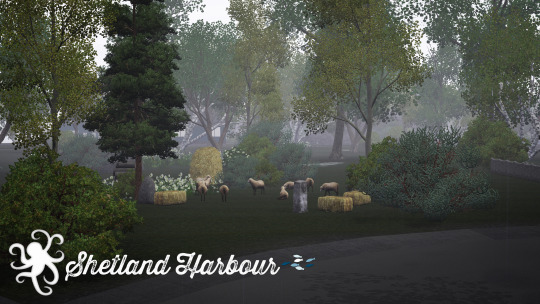
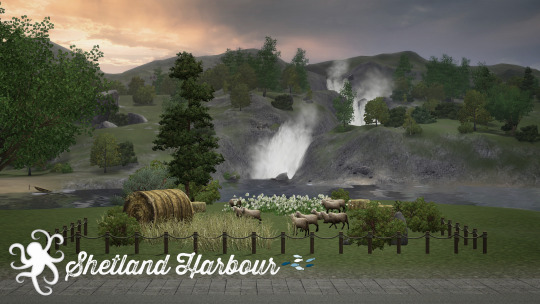

Download Shetland Harbour today and start your new adventure!
\o/
- - - - - - - - - - - - - - - - - - - - - - -
IMPORTANT : Before downloading Shetland Harbour !!!
Shetland Harbour contains custom content. As much as we try to include them into the world building process, we learned with time the necessity of providing a list those items. No worries, we used the same cc creators as usual and added 2 or 3 more. Such as the grey/dark roof we made, based on the terracotta roof of the game and the Wood walls you'll find on different lots, the same as the ones of Oaksoak Hollow ... Or more important, the boats used in the world and of course ... The sheeps ! All you need should be included and/or available down here ;)
1) the ANTS & CC :)
ANTS stand for Absolute Necessary Things & Stuff to enjoy Shetland Harbour :)
Download ANTS and CC ( both are needed to have all the right textures, the right look and feel of Shetland Harbour )
You will need too some of our Rabbit Holes
Not mandatory but nice : our 88 Patterns mostly brick, masonry, concrete and wood ;) A bit of fabric & paper too ...
ATTENTION : if you have played with one of our Worlds, you might see duplicate files. We try to use the same objects as much as possible. Of course, you don't have to install twice. Skip whatever you already have. We use Blams objects for some Sims 3 objects ... so if you already have those objects from any other means, just skip ;)
CREDITS & THANKS due to all the following creators :
ATS, Noir and Dark Sims, pitheinfinite, Brunnis-2, Blams, CycloneSue, HydrangeaChainsaw, Leroy157, Lisen801, Murfeele, Nilxis, PotatoBalladSims, Qahne, TheJim07, Mammut ( from BlackSimsZoo ) BlueCoco, BuffSumm, JomSims, Ladesire, Mutske
2) the Saved Games
They are in the same page than Shetland Harbour itself. You have the choice between Unpopulated and Half-populated. Whatever you choose, we always strongly advice with a save game ;) But as far we know, once we delivered a World, it is entirely up to you to begin a new adventure and make your own challenges with your own Sims :D
Download a save game
3) the Lots ( both residential & community )
Quite a bursting town, Shetland Harbour has 100 lots : 65 residential and 35 community and very important : many small sheep fields ( visitors not allowed com lots )
Download ALL the lots
Some lots are Maxis ones we modified, some lots are our own creations, and for the others, they come mostly from MTS ;) And we are very grateful to those creators who always offer a special flavor to our Worlds :)
CarlDillynson - Bellakenobi - Bast - MySimRealty - stonee206 - Norn - Cutbacks - Ferguson Avenue - SimplySimlish - hazelnutter100 - PolarBearSims - RubyRed2021 - CircusWolf - Moihi - Lasciel
Well, it is time for discovery now and you are ready for sure ! We wish you all the best, all the fun with your new life in Shetland Harbour !
Download Shetland Harbour World
PS : Shetland Harbour is a medium/large sized world of 88MB, and has been tested 1 week long on both Mac and Pc ;)
xoxo - blackgryffin
#the sims 3#sims 3 gameplay#sims 3#thesims3#ts3#sims3 worlds#sims3 build#shetland harbour#sims 3 world#sims3 cc#k hippie#k-hippie
745 notes
·
View notes
Text
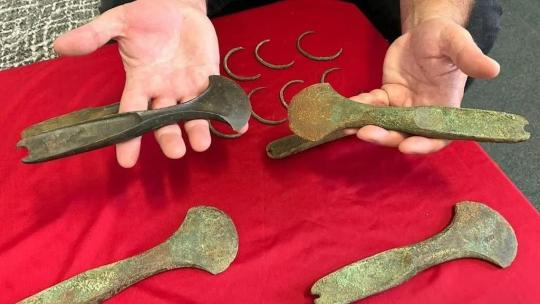
3,600-Year-Old Jewelry and Weapon Hoard Found Under Field in Czech Republic
Archaeologists used metal detectors to find the hoard, which includes several pieces of jewelry and weapons.
Archaeologists discovered a hoard of Bronze Age artifacts while doing routine survey work in a field in the Czech Republic.
The bronze objects — which include eight arm rings, two pins, eight axes and one spearhead — were found near Budyně nad Ohří, a town about 35 miles (56 kilometers) northwest of Prague, Radio Prague International reported.
Researchers estimate that most of the items, which they found using metal detectors, date to around 1600 B.C.
"Most items are characteristic of the Middle Bronze Age, with only one ax belonging to the earlier period," Martin Trefný, an associate professor at the Museum of the Říp Region and the University of Jan Evangelista Purkyně and the curator of the hoard, said in an email. One ax is even older and dates to the Early Bronze Age.
"Axes could have been used as tools or weapons. The latter function also applies to the spearhead," Trefný said. "Bracelets were forearm ornaments, and pins served either to fasten clothing or, for example, to style women's hair."
Archaeologists remain unclear about why the hoard was buried, but they have proposed three possibilities.
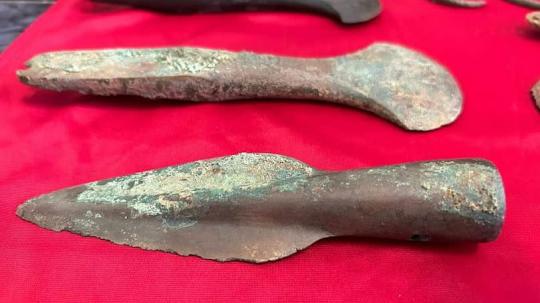
"In the first case, the hoards are presumed to have a votive function, meaning they served as offerings to deities," Trefný said. "In the second case, we speak of an economic function, where hoards are interpreted as, for example, storage for manufacturers of the given items."
Alternatively, the buried items could reflect "a crisis situation, where it was necessary to hide the items, for example, from enemies," he said.
The treasure could be worth "millions of crowns," Trefný told Radio Prague International. (One million Czech crowns, or koruna, is about $42,500.)
"All the items testify to the technological advancement of bronze casters and processors in Central Europe 3,500 years ago," Trefný told Live Science. "The composition of the hoard also contributes to understanding the warfare, craft techniques and contemporary fashion of the time. Considering that hoards might have a ritual significance, they can also reveal a bit about the contemporary religion."
In the "near future," these found items will be on display at the Podřipské Museum, located about 30 miles (50 km) north of Prague, Radio Prague International reported.
By Jennifer Nalewicki.

#3600-Year-Old Jewelry and Weapon Hoard Found Under Field in Czech Republic#Budyně nad Ohří#metal detector#metal detecting finds#bronze#ancient artifacts#archeology#archeolgst#history#history news#ancient history#ancient culture#ancient civilizations#bronze age
111 notes
·
View notes
Photo

Elliott Erwitt Ann Slavit’s Inflatable Sculpture, “Della Street,” Exhibited at the Museum of Contemporary Crafts, New York City 1978
1K notes
·
View notes
Text
Fishskin Robes of the Ethnic Tungusic People of China and Russia
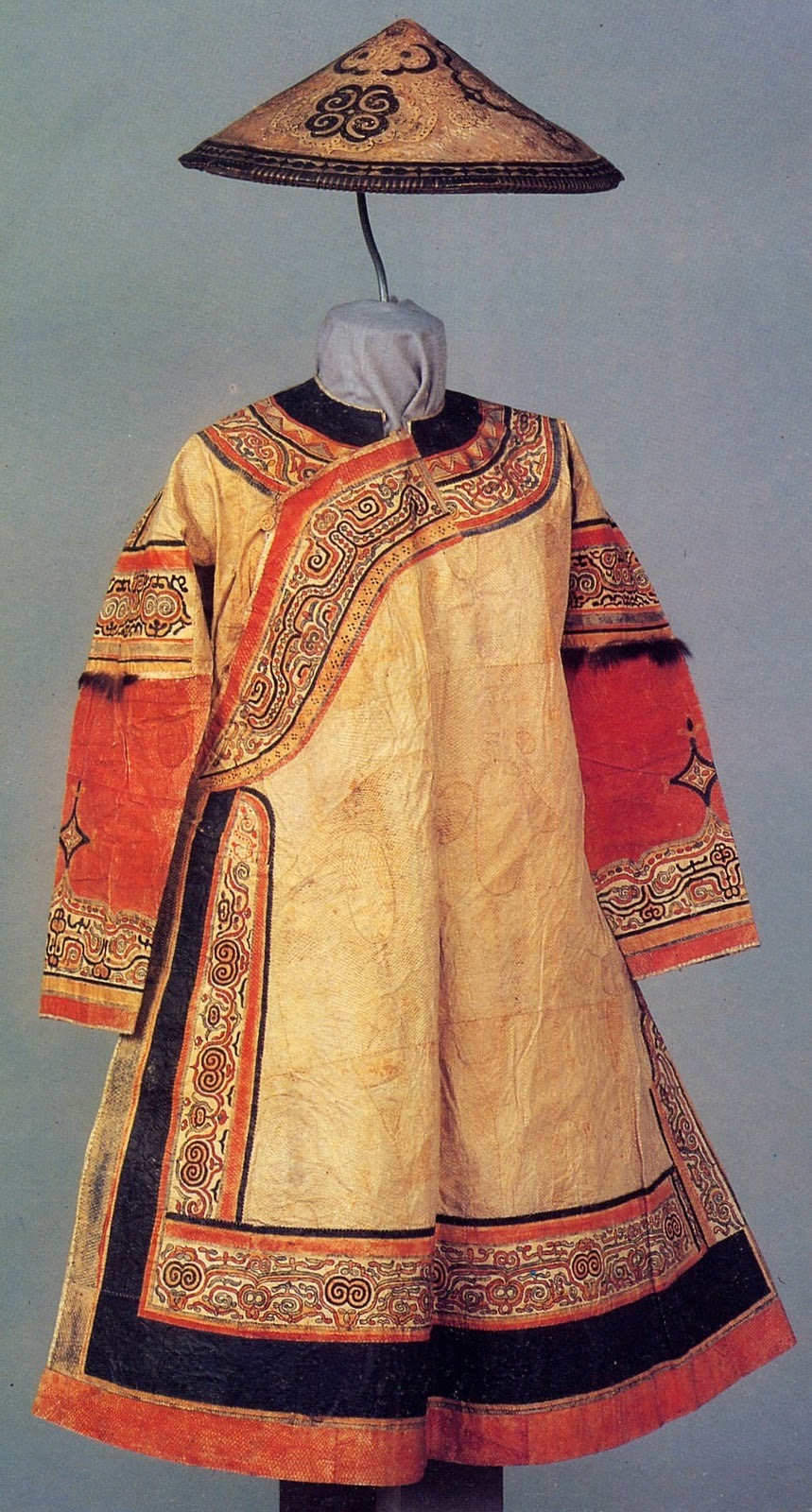
Oroch woman’s festive robe made of fish skin, leather, and decorative fur trimmings [image source].
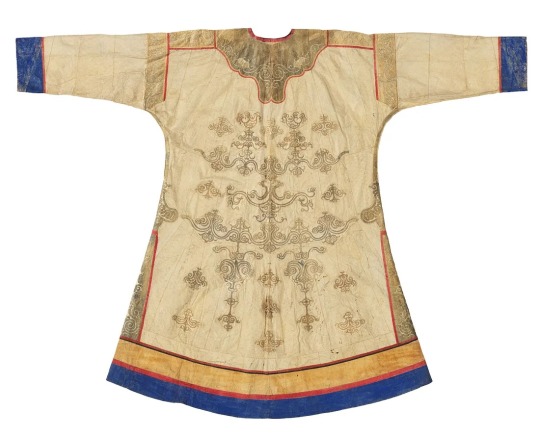
Nivkh woman’s fish-skin festival coats (hukht), late 19th century. Cloth: fish skin, sinew (reindeer), cotton thread; appliqué and embroidery. Promised gift of Thomas Murray L2019.66.2, Minneapolis Institute of Art, Minnesota, United States [image source].
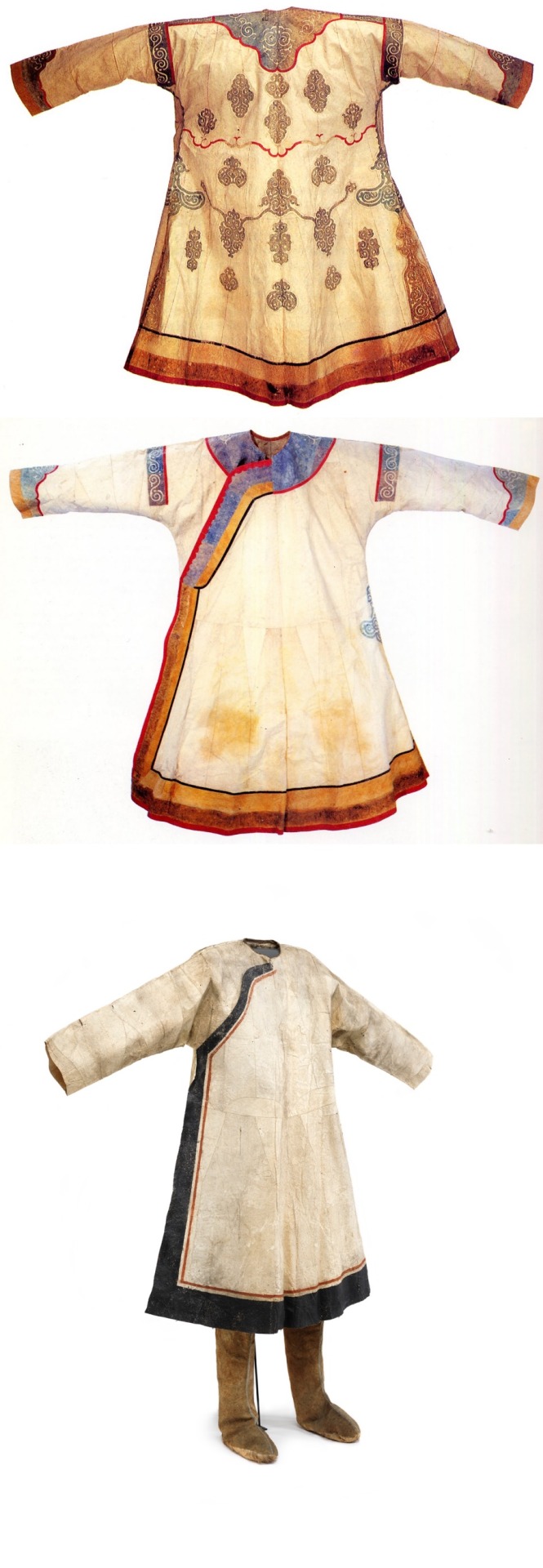
Back view of a Nivkh woman’s robe [image source].
Front view of a Nivkh woman’s robe [image source].
Women’s clothing, collected from a Nivkh community in 1871, now in the National Museum of Denmark. Photo by Roberto Fortuna, courtesy Wikimedia Commons [image source].
The Hezhe people 赫哲族 (also known as Nanai 那乃) are one of the smallest recognized minority groups in China composed of around five thousand members. Most live in the Amur Basin, more specifically, around the Heilong 黑龙, Songhua 松花, and Wusuli 乌苏里 rivers. Their wet environment and diet, composed of almost exclusively fish, led them to develop impermeable clothing made out of fish skin. Since they are part of the Tungusic family, their clothing bears resemblance to that of other Tungusic people, including the Jurchen and Manchu.
They were nearly wiped out during the Imperial Japanese invasion of China but, slowly, their numbers have begun to recover. Due to mixing with other ethnic groups who introduced the Hezhen to cloth, the tradition of fish skin clothing is endangered but there are attempts of preserving this heritage.
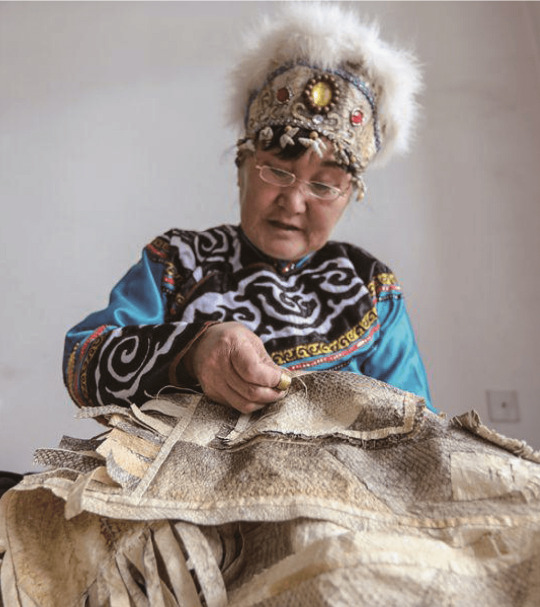
Hezhen woman stitching together fish skins [image source].


Top to bottom left: You Wenfeng, 68, an ethnic Hezhen woman, poses with her fishskin clothes at her studio in Tongjiang, Heilongjiang province, China December 31, 2019. Picture taken December 31, 2019 by Aly Song for Reuters [image source].
Hezhen Fish skin craft workshop with Mrs. You Wen Fen in Tongjian, China. © Elisa Palomino and Joseph Boon [image source].
Hezhen woman showcasing her fishskin outfit [image source].
Hezhen fish skin jacket and pants, Hielongiang, China, mid 20th century. In the latter part of the 20th century only one or two families could still produce clothing like this made of joined pieces of fish skin, which makes even the later pieces extremely rare [image source].
Detail view of the stitching and material of a Hezhen fishskin jacket in the shape of a 大襟衣 dajinyi or dajin, contemporary. Ethnic Costume Museum of Beijing, China [image source].
Hezhen fishskin boots, contemporary. Ethnic Costume Museum of Beijing, China [image source].
Although Hezhen clothing is characterized by its practicality and ease of movement, it does not mean it’s devoid of complexity. Below are two examples of ornate female Hezhen fishskin robes. Although they may look like leather or cloth at first sight, they’re fully made of different fish skins stitched together. It shows an impressive technical command of the medium.
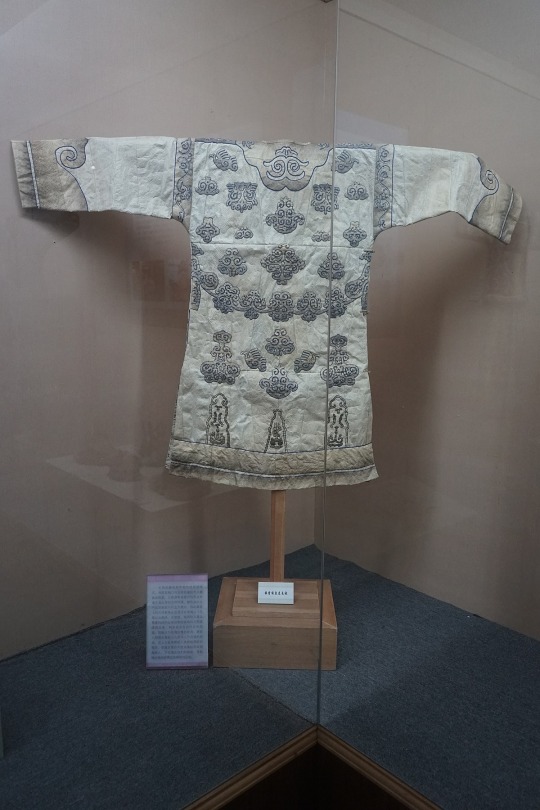
赫哲族鱼皮长袍 [Hezhen fishskin robe]. Taken July 13, 2017. © Huanokinhejo / Wikimedia Commons, CC BY 4.0 [image source].
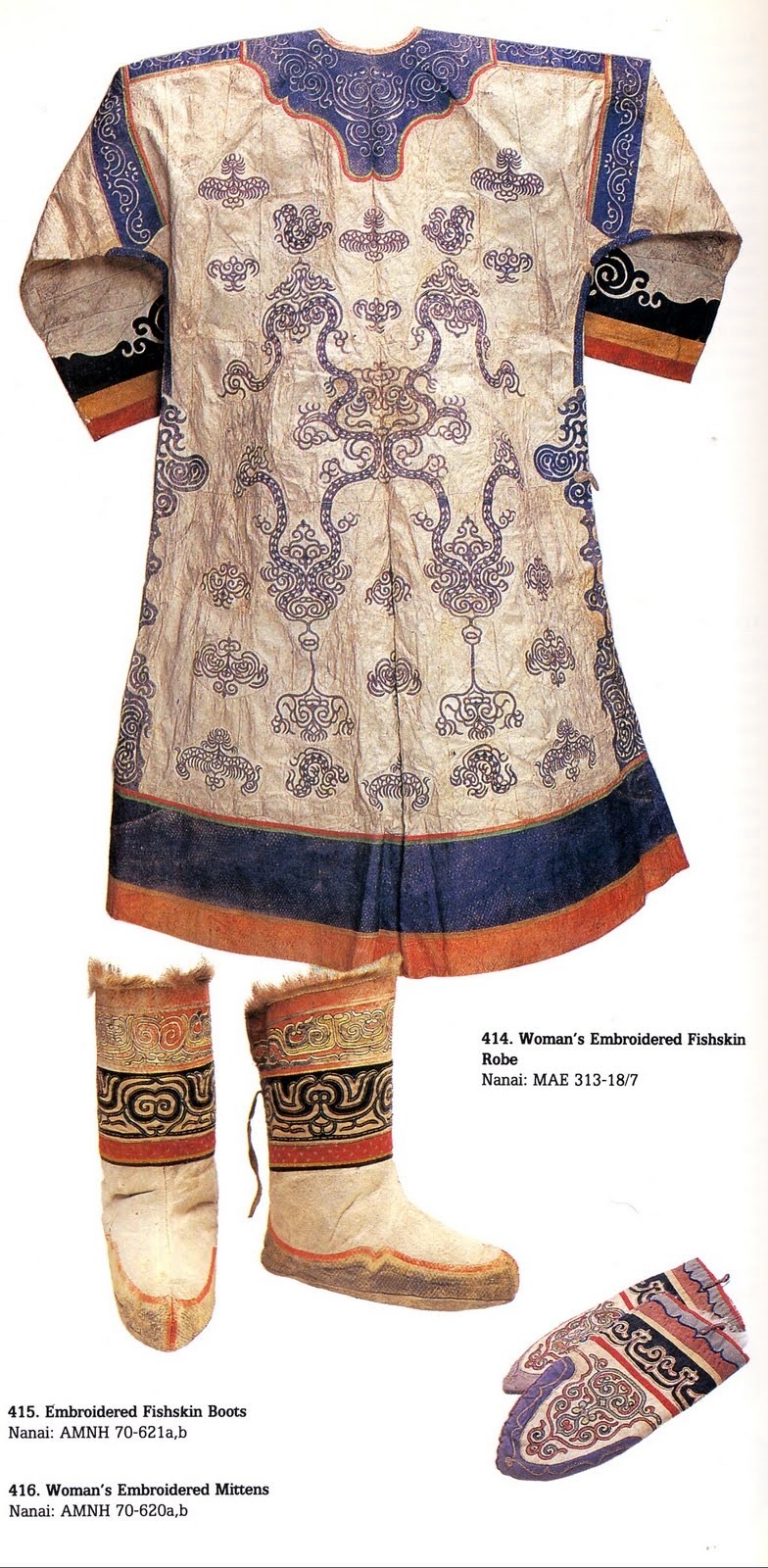
Image containing a set of Hezhen clothes including a woman’s fishskin robe [image source].
The Nivkh people of China and Russia also make clothing out of fish skin. Like the Hezhen, they also live in the Amur Basin but they are more concentrated on and nearby to Sakhalin Island in East Siberia.


Top to bottom left: Woman’s fish-skin festival coat (hukht) with detail views. Unknown Nivkh makers, late 19th century. Cloth: fish skin, sinew (reindeer), cotton thread; appliqué and embroidery. The John R. Van Derlip Fund and the Mary Griggs Burke Endowment Fund; purchase from the Thomas Murray Collection 2019.20.31 [image source].
Top to bottom right: detail view of the lower hem of the robe to the left after cleaning [image source].
Nivkh or Nanai fish skin boots from the collection of Musée du quai Branly -Jacques Chirac. © Marie-Lan Nguyen / Wikimedia Commons, CC BY 4.0 [image source].
Detail view of the patterns at the back of a Hezhen robe [image source].
Read more:
#china#russia#tungusic#hezhe#nanai#fishskin#ethnic minorities#nivkh#chinese culture#history#russian culture#amur basin#heilongjiang#east siberia#ethnic clothing
993 notes
·
View notes
Note
Hey can I get your "history worker slash person who sews "insight on the words seamstress and tailor? Which ones do you use in a modern context? I just despise the contemporary word "sewist" but like. How do you best describe what you do (as a hobby, not professionally)? The gender implications are weird too..
Oh man. You have to realize that I LOVE feminized terms for myself. Adore them. If there were a word for a lady museum professional, I would use it all the time. I am Extremely Woman and I love shoving it in everyone else's face as much as possible. So I do really like "seamstress."
...but I've recently come to the realization that, in my period of greatest interest "seamstress" often just meant "woman who does basic sewing, not cutting and fitting and designing feminine garments." That was a dressmaker. So I use "hobbyist seamstress" and "hobbyist dressmaker" interchangeably. (There is no gendered term for dressmaker because it was often Assumed FemaleTM in the past. To the point where male dressmakers were sometimes called "man-dressmakers" and their hatmaking counterparts, "man-milliners." This sometimes carried connotations of homosexuality- though I've also seen an apparently hetero man, who owned a dressmaking business that his wife ran, called a "ladies' tailor." History is fascinating.)
Sewist is fine with me- I've also heard tailor used as a more masculine term, though some would argue that that has a distinct and specific meaning in the sewing world.
It's kind of a lacuna in sewing lingo, I agree! There really aren't many non-gendered terms for One Who Sews, or at least ones that aren't arguably for specific functions within the craft.
Of course you could always make like Amanda McKittrick Ros, wide-hailed Worst Writer of the 19th Century, and say that you engage in
"...the use of the finest production of steel, whose blunt edge eyed the reely covering with marked greed, and offered its sharp dart to faultless fabrics of flaxen fineness." (Delina Delaney, 1898)
83 notes
·
View notes
Text
石川県
Japanese Prefectures: Chūbu - Ishikawa
都道府県 (とどうふけん) - Prefectures of Japan
Learning the kanji and a little bit about each of Japan’s 47 prefectures!
Kanji・漢字
石 いし、セキ、シャク、コク stone
川 かわ、セン stream, river
県 ケン prefecture
中部 ちゅうぶ Chūbu, Central Japan, the central region of Japan
Prefectural Capital (県庁所在地) : Kanazawa (金沢市)

Ishikawa Prefecture lies along the scenic north coast of Honshu, the main island of Japan, and is part of the central region, known as Chūbu (中部) or Hokuriku (北陸). Ishikawa combines contemporary art and ancient crafts, stunning ocean or mountain views, relaxing hot springs and traditional Japanese inns. Kanazawa boasts a vibrant geigi (芸妓) culture (think geisha), a bustling seaport in Kaga, and mountainous terrain in the Hakusan region.
This region was hit by the 2024 New Year's Noto Peninsula earthquake, with the most devastation occurring in the northern part of the peninsula. Many businesses and much of the economy relies heavily on tourism, and now is a good time to visit to assist in revitalizing the community, especially in minimally affected areas such as Kanazawa and Kaga.
Recommended Tourist Spot・おすすめ観光スポット Kutani Ceramic Art Village - 九谷陶芸村

Kutaniyaki (Kutani ware) (source)
Kutani ware is probably the best known in Ishikawa and the Noto peninsula. There are many kutani ware souvenirs to be found in Ishikawa, and you can even take classes to make your own pottery. Kutani ware contains five distinctive colors: red, yellow, green. purple, and blue. The rules for Kutani ware are few, so the freedom allowed in creating the pottery is practically endless. The high quality of the porcelain stone found in Ishikawa further lends itself to the distinctiveness of the pottery. In the city of Nomi you can find the Kutani Ceramic Art Village, which is also home to a museum documenting the history Kutani ware and how it is made. Nearby is Cerabo Kutani, a workshop where you can make your own Kutani ware pottery.
The history of this pottery dates back to 1655, when the first daimyo feudal lords of what was then the Daishoji domain wanted to make the most of the porcelain stone found in the area. A gold smelter was sent to Saga Prefecture to learn pottery, and when he returned he opened a kiln in the village of Kutani. This pottery became known as Ko Kutani, a predecessor to Kutani ware in its present form. This kiln operated for 50 years, and then closed down, for reasons unknown to historians.
The next kiln was opened in 1805, when a craftsman skilled in Kyoto pottery came to Ishikawa with his apprentice. The apprentice found the porcelain stone that is local to the area, and the pottery that they created became the modern day Kutani ware.
Regional Cuisine - 郷土料理 Kanazawa Oden - 金沢おでん

Kanazawa oden (source)
Oden is a popular traditional street food dish that can be traced back to the Edo period (1603-1868) in Japan. It is traditionally a dish of various ingredients simmered in soy-based broth and the simple yet warm and nourishing dish can still be found all over Japan today.
Kanazawa oden is a regional variation from the city of Kanazawa in Ishikawa, and is particularly distinctive from other types of oden due to the broth, which is carefully crafted from a blend of soy sauce, dashi (stock made from kombu seaweed and bonito flakes), and other seasonings such as mirin, sake, ginger, and garlic. Kanazawa oden ingredients include crab (only available in the winter!), plum shell conch, and fish balls. Kaga vegetables such as gensuke radish and wheat gluten are also staples in this dish.
Although Kanazawa oden can be enjoyed year-round, to get kani-men or stuffed crab shell you need to visit in the winter months.
Ishikawa Dialect・Ishikawa hougen・石川方言
The dialects of Ishikawa Prefecture are Kaga dialect (加賀弁, Kaga-ben) spoken in the southern part of the prefecture, and the Noto dialect (能登弁, Noto-ben) spoken in the northern part. There are also multiple dialects within each of the primary dialects, thanks to the mountains separating the villages. The below examples are primarily Kanazawa dialect.
1. あんやと、あんがと anyato, angato
Standard Japanese: ありがとう (arigatou) English: thank you
ああ、あんやと。 ah, anyato
ああ、ありがとう。 ah, arigatou
Oh, thank you.
2. ~しまっし ~shimasshi
Standard Japanese: ~してください、~しなさい (~shite kudasai, ~shinasai) English: please do ~, do ~
そこへ座るまっしね。 soko e suwaru masshi ne.
そこへ座ってくださいね。 soko e suwatte kudasai ne.
Please go ahead and sit there.
*Note: The masshi structure is the most famous Kanazawa dialect. This is also the catch phrase for visiting Kanazawa: 来まっし、金沢! Kimasshi, Kanazawa! (Come to Kanazawa!)
3. ほうや、ほうや! (houya, houya)
Standard Japanese: そうだそうだ (sou da sou da) English: that's right, that's right
A: だちゃっかんわいね。 B: ほうや、ほうやね。 A: dachakkannwaine. B: hou ya, hou ya ne.
A: だめだね。 B: そうだ、そうだね。 A: dachakkannwaine. B: sou da, sou da ne.
A: That's not good, is it? B: That's right, that's right.
4. あゆるしゅう、あゆっしゅ (ayurushuu, ayusshu)
Standard Japanese: よろしく (yoroshiku) English: nice to meet you, I'll leave it to you, please do etc.
A: デザートもたのむん? A: dezaato mo tanomun? B: あゆるしゅう。 B: ayurushuu.
A: デザートも頼むの? dezaato mo tanomu no? B: よろしく。 B: yoroshiku.
A: Are we ordering dessert too? B: Please do.
5. なーんも、なーん (naan mo, naan)
Standard Japanese: いいよ (ii yo) English: it's ok, don't worry
なぁーん、いいがや。 naan, ii ga ya.
いいえ、心配しないで。 iie, shinpai shinai de.
No, it's ok, don't worry.
More Ishikawa dialect here (JP).
#japanese prefectures#日本語#japanese#japanese language#japanese langblr#langblr#studyblr#都道府県#石川県#ishikawa
33 notes
·
View notes
Text
Who is...
Lady Athena?
Lady Athena is a #Hellenic goddess worshiped in Ancient Greece and beyond. Like many of the Ancient Greek Gods, Heroes and Lore, the story of her birth is not quite average. Zeus, mighty ruler of Olympus had received a warning, that one of his sons would take his throne & strip him of his power, as he himself had done with his father Cronos. So like his father, Zeus decided that cannibalism will solve his problem and swallowed his first lover, Metis, a beautiful Okeanide (Daughters of Okeanos and Thetys), while she was pregnant. Instead of bearing him the promised son, a wise girl, with the attire of a warrior was born from Zeus' head. Hephaistos, the disabled god of fire, metallurgy, and crafts came to aid Zeus as a midwife, effectively splitting his head open with an axe, to make way for Zeus' most beloved daughter, Athene, who stepped forth, with eyes of steal and fully armoured. If this is a special benefit of having a divine blacksmith midwife or a side effect of cannibal birth through your father's head is unknown.

("The birth of Athena" - Vase painting from 555 - 550 B.C. by the Phrynos Painter - British Museum, London)
Little Athene however was soon sent to be raised and educated in the arts of war, by the God Triton, alongside of his daughter Pallas, who became her companion (read: potentially wlw lover). Training together, the two girls would fight against each other with sword and shield and both were so skilled in their doing, that Zeus started to worry about his daughter, interfering in their play. This startled Pallas so much that she missed to parry a thrust of Athena's sword and got lethally wounded. According to some interpretations Athena was so devastated about the death of her lover, that she took her name as her own, to immortalize her memory and henceforth was known as Pallas Athena, whereas other interpretations identify Athena as aromantic or asexual.


(1. Contemporary bronze figurine of Athena, taking the fierce stance of a warrior with her iconic Medusa shield, her helmet and spear.) (2. Alternative shield of Athene's sporting the owl emblem, a symbol of her wisdom and crest to the city of Athens.)
Pallas is also synonymous with the word "girl" which goes hand in hand with another epithet of Athene's: Parthenos, meaning "maiden". In other words, Athena was known as the "Girl Athena" or "Maiden Athena", implying that she was rather young. Despite her everlasting young age, Athena became known as the wisest and most skilled warrior. Unlike Ares, God of war, her skills lie particularly with wisdom, protection and defense as well as diplomacy and righteousness, with which she aided many Greek heroes like Hercules, Perseus, Achilles and Odysseus according to Hellenic lore. Being an INFP (MBTI type) myself, and therefore a diplomat, I always admired her for these particular traits and often seek her council, aid and guidance, in order to act thoughtful and not get carried away by heated emotions, especially in the face of conflict and problems. (I'm not always successful, but that's why we ask for help. 😂)

("Athena Protects the young Hero" - Berlin)
Furthermore she is the patron goddess of arts and crafts, specifically those that serve the creation of useful objects and tools, but especially of crafts connected to thread and fabric. Notably she is also known as the Patron of Greece's capital city Athens, who sports an owl emblem in it's crest in her honour. The people of Attica chose her as such, after she gifted them with the invention of the olive tree, rooting the discovery of olives and their products in the hands of Greece, according to their lore. Furthermore she is known as patroness of Sparta, founder of Thebes and in association with the city of Corinth. Later Athena was also associated with Hygieia (goddess of health, cleanliness and hygiene) and the Hippocratic oath, a pledge physicians make before various healing gods to practice medicine and healing in a honourful and ethical way. Therefore Athena is also sometimes depicted with a serpent-staff, like Asclepios.

(Athena as restored by Algardi - Museo nazionale romano di palazzo, Altemps)
Some animals & objects associated with Athene are:
The Owl and Serpent - symbols of wisdom
The Horse - symbol of equestrian skills
The olive tree - symbol of victory
Armour, Helmet, Shield and Spear - symbols of divine authority, protection, wisdom and strategy
Sphinx and Griffins - symbols of power, domestication and taming of the wild spirits, abundance
Well received offering for Athene are:
Food like bread, meat, milk, honey, cakes, barley meal, olive oil, fruit, wine and pure water
Olives and Olive Branches
Flowers, especially white roses
Spices, especially cinnamon
Burning or offering incense
Crystals, amongst others Sodalite, Marble, Shungite, Fluorite, Granite, Amethyst, Dumortierite, a number of quartzes, emeralds and opals
Dedicational work and worship can include:
Studying, reading and educating yourself
Promoting peace and seeking diplomatic solutions and conversations to resolve conflict
Arts and crafts, especially weaving, knitting, crocheting
Learn and practice martial arts
Educating or writing informational works

(Athena with Owl and Shield, Replica)
#hellenic worship#hellenic pagan#hellenic deities#hellenism#athena worship#pallas athena#athena#hellenic devotion#devotional blog#hellenic polytheism#goddess athena
20 notes
·
View notes
Note
Can you make a post about the evolution of Greek art from the ancient times until now in modern age?
Because we often talk about the evolution of art but unfortunately we don't appreciate after ancient times the other art movements Greece went through the centuries.
That’s true! I am sorry for taking ages to answer this but I don't know how it could take me less anyway hahaha I made this post with summaries about all artistic eras in Greek history. I have most of it under a cut because with the addition of pictures it got super long, but if you are interested in the history of art I recommend giving it a try! I took advantage of all 30 pictures that can be possibly attached in a tumblr post and I tried to cover as many eras and art styles as possible, nearly dying in the process ngl XD I dedicated a few more pictures in modern art, a) because that was the ask and b) because there is more diversity in the styles that are used and the works that are available to us in great condition in modern times.
History of Greek Art
Greek Neolithic Art (c. 7000 - 3200 BC)
Obviously, with this term we don’t mean there were people identifying as Greeks in Neolithic times, but it defines the Neolithic art corresponding to the Greek territory. Art in this era is mostly functional, there are progressively more and more defined designs on clay pots, tools and other utility items. Clay and obsidian are the most used materials.
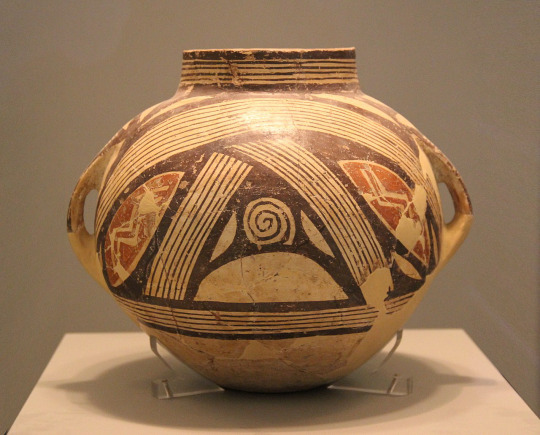
Clay vase with polychrome decoration, Dimini, Magnesia, Late or Final Neolithic (5300-3300 BC).
Cycladic Art (3300 - 1100 BC)
The art of the Cycladic civilisation of the Aegean Islands is characterized by the use of local marble for the creation of sculptures, idols and figurines which were often associated to womanhood and female deities. Cycladic art has a unique way of incidentally feeling very relevant, as it resembles modern minimalism.
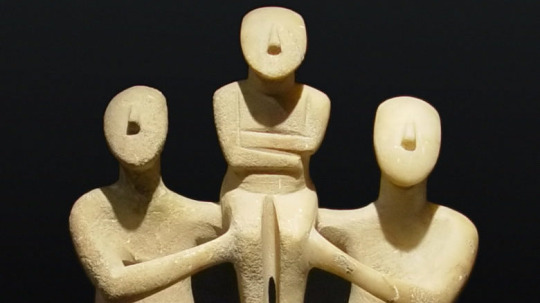
Early Cycladic II (Keros-Syros culture, 2800–2300 BC)
Minoan Art (3000-1100 BC)
The advanced Minoan civilisation of Crete island was projecting its confidence and its vibrancy through its various arts. Minoan art was influenced by the earlier Egyptian and Near East cultures nearby and at its peak it overshadowed the rest of the contemporary cultures and their artistic movements in Greece. Colourful, with numerous scenes of everyday life and island life next to the sea, it was telling of the society’s prosperity.
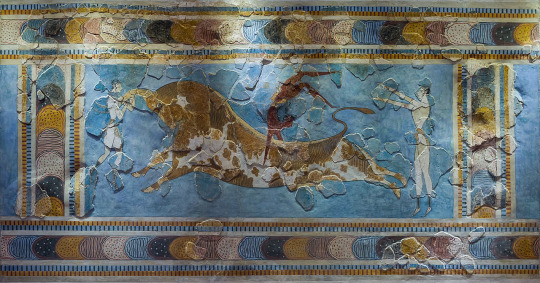
The Bull-leaping fresco from Knossos, 1450 BC.
Mycenaean Art (c. 1750 - 1050 BC)
Mycenaean Art was very influenced by Minoan Art. Mycenaean art diverged and distinguished itself more in warcraft, metalwork, pottery and the use of gold. Even when similar, you can tell them apart from their themes, as Mycenaean art was significantly more war-centric.
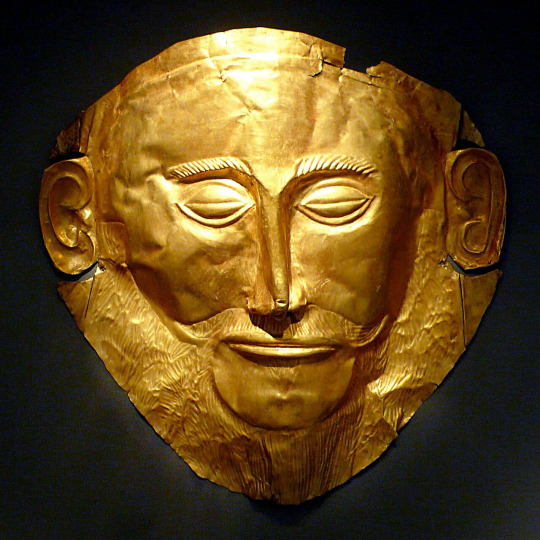
The Mask of Agamemnon in the National Archaeological Museum of Athens. The mask likely was crafted around 1550 BC so it predates the time Agamemnon perhaps lived.
Geometric Art (1100 - 700 BC)
Corresponding to a period we have comparatively too little data about, the Geometric Period or the Homeric Age or the Greek Dark Ages, geometric art was characterized by the extensive use of geometric motifs in ceramics and vessels. During the late period, the art becomes narrative and starts featuring humans, animals and scenes meant to be interpreted by the viewer.

Detail from Geometric Krater from Dipylon Cemetery, Athens c. 750 BC Height 4 feet (Metropolitan Museum, New York)
Archaic Art (c. 800 - 480 BC)
The art of the archaic period became more naturalistic and representational. With eastern influences, it diverged from the geometric patterns and started developing more the black-figure technique and later the red-figure technique. This is also the earliest era of monumental sculpture.
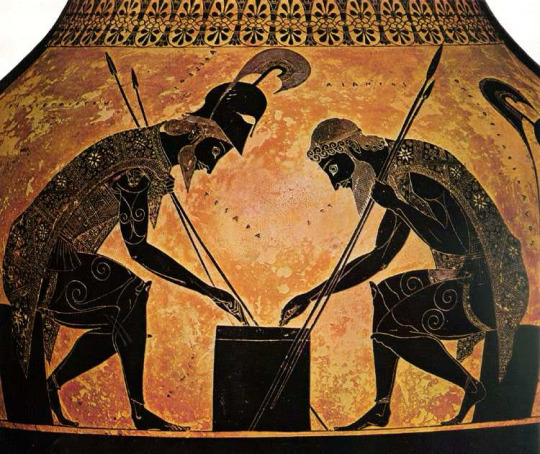
Achilles and Ajax Playing a Board Game by Exekias, black-figure, ca. 540 B.C.
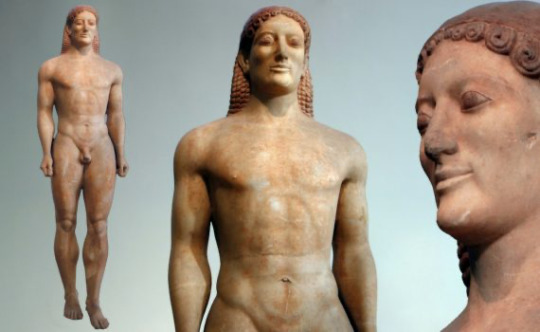
Kroisos Kouros, c. 530 B.C.
Classical Art (c. 480 - 323 BC)
Art in this era obtained a vitality and a sense of harmony. There is tremendous progress in portraying the human body. Red-figure technique definitively overshadows the use of the black-figure technique. Sculptures are notable for their naturalistic design and their grandeur.
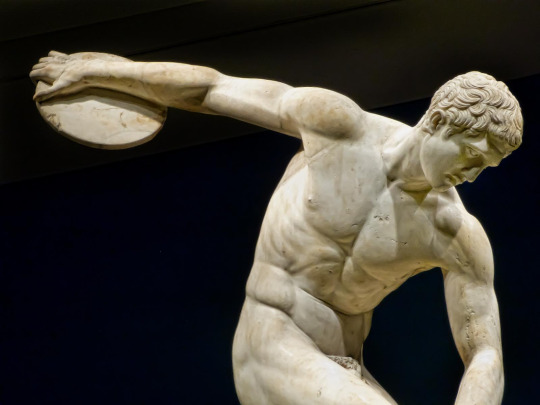
The Diskobolos or Discus Thrower, Roman copy of a 450-440 BCE Greek bronze by Myron recovered from Emperor Hadrian’s Villa in Tivoli, Italy. (British Museum, London). Photo by Mary Harrsch.

Terracotta bell-krater, Orpheus among the Thracians, ca. 440 BCE, The Metropolitan Museum of Art.
Hellenistic Art (323 - 30 BCE)
Hellenistic art perfects classical art and adds more diversity and nuance to it, something that can be explained by the rapid geographical expansion of Greek influence through Alexander’s conquests. Sculpture, painting and architecture thrived whereas there is a decrease in vase painting. The Corinthian style starts getting popular. Sculpture becomes even more naturalistic and expresses emotion, suffering, old age and various other states of the human condition. Statues become more complex and extravagant. Everyday people start getting portrayed in art and sculpture without extreme beauty standards imposed. We know there was a huge rise in wall painting, landscape art, panel painting and mosaics.

Mosaic from Thmuis, Egypt, created by the Ancient Greek artist Sophilos (signature) in about 200 BC, now in the Greco-Roman Museum in Alexandria, Egypt. The woman depicted in the mosaic is the Ptolemaic Queen Berenike II (who ruled jointly with her husband Ptolemy III) as the personification of Alexandria.

Agesander, Athenodore and Polydore: Laocoön and His Sons, 1st century BC
Greco-Roman Art (30 BC - 330 AD)
This period is characterized by the almost entire and mutually influential merging of Greek and Roman artistic expression, in light of the Roman conquest of the Hellenistic world. For this era, it is hard to find sources exclusively for Greek art, as often even art crafted by Greeks of the Roman Empire is described as Roman. In general, Greco-Roman art reinforces the new elements of Hellenistic art, however towards the end of the era, with the rise of early Christianity in the Eastern aka the Greek-influenced part of the empire, there are some gradual shifts in the art style towards modesty and spirituality that will in time lead to the Byzantine art. During this era mosaics become more loved than ever.
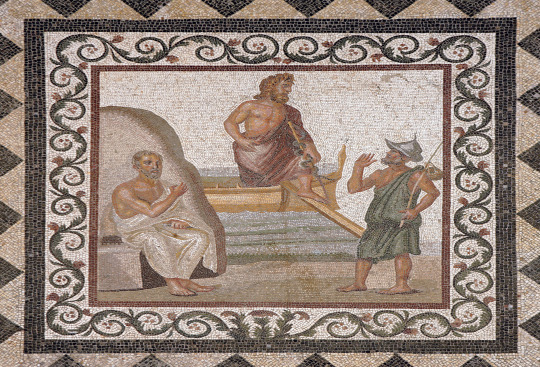
A mosaic from the island of Kos (the birthplace of Hippocrates) depicting Hippocrates (seated) and a fisherman greeting the god Asklepios (center) as he either arrives or disembarks from the island. Second or third century CE.
Introduction to Byzantine Art
Byzantine art originated and evolved from the now Christian Greek culture of the Eastern Roman Empire. Although the art produced in the Byzantine Empire was marked by periodic revivals of a classical aesthetic, it was above all marked by the development of a new aesthetic defined by its salient "abstract", or anti-naturalistic character. If classical art was marked by the attempt to create representations that mimicked reality as closely as possible, Byzantine art seems to have abandoned this attempt in favor of a more symbolic approach. The subject matter of monumental Byzantine art was primarily religious and imperial: the two themes are often combined.
Early Byzantine Art (330 - 842 AD)
The establishment of the Christian religion results in a new artistic movement, centered around the faith. However, ancient statuary remains appreciated. Most fundamental changes happen in monumental architecture, the illustration of manuscripts, ivory carving and silverwork. Exceptional mosaics become integral in artistic expression. The last 100 years of this period are defined by the Iconoclasm, which temporarily restricts entirely the previously thriving figural religious art.

Mosaics in the Rotunda of Thessaloniki, 4th - 6th century AD.
Macedonian Art & Komnenian Age (843 - 1204 AD)
These artistic periods correspond to the middle Byzantine period. After the end of the Iconoclasm, there is a revival in the arts. The art of this period is frequently called Macedonian art, because it occurred during the Macedonian imperial dynasty which generally brought a lot of prosperity in the empire. There was a revival of interest in the depiction of subjects from classical Greek mythology and in the use of Hellenistic styles to depict religious subjects. The Macedonian period also saw a revival of the late antique technique of ivory carving. The following Komnenian dynasty were great patrons of the arts, and with their support Byzantine artists continued to move in the direction of greater humanism and emotion. Ivory sculpture and other expensive mediums of art gradually gave way to frescoes and icons, which for the first time gained widespread popularity across the Empire. Apart from painted icons, there were other varieties - notably the mosaic and ceramic ones.
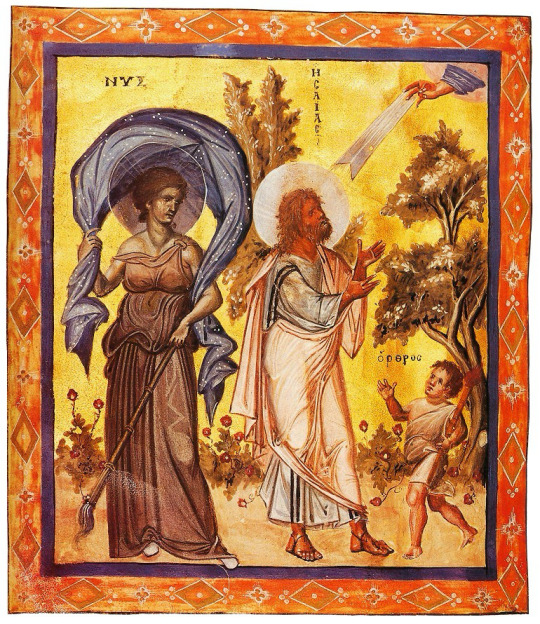
Paris Psalter, 10th century AD. Prophet Isaiah from the Old Testament in the company of the symbolisms for night (clear inspiration drawn from the ancient deity Nyx) and morning (Orthros, not to be confused with the mythological creature).
Palaeologan Renaissance (1261 - 1453)
The Palaeologan Renaissance is the final period in the development of Byzantine art. Coinciding with the reign of the Palaeologi, the last dynasty to rule the Byzantine Empire (1261–1453), it was an attempt to restore Byzantine self-confidence and cultural prestige after the empire had endured a long period of foreign occupation. The legacy of this era is observable both in Greek culture after the empire's fall and in the Italian Renaissance. Contemporary trends in church painting favored intricate narrative cycles, both in fresco and in sequences of icons. The word "icon" became increasingly associated with wooden panel painting, which became more frequent and diverse than fresco and mosaics. Small icons were also made in quantity, most often as private devotional objects.
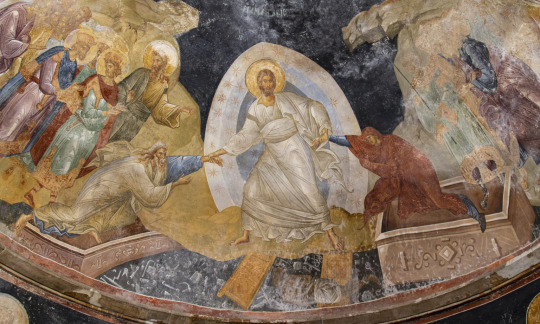
Detail of Anástasis (Resurrection) fresco, c. 1316–1321, Chora church, Constantinople (Istanbul) (photo: byzantologist).
Cretan School (15th - 17th century)
Cretan School describes an important school of icon painting, under the umbrella of post-Byzantine art, which flourished while Crete was under Venetian rule during the Late Middle Ages, reaching its climax after the Fall of Constantinople, becoming the central force in Greek painting during the 15th, 16th and 17th centuries. By the late 15th century, Cretan artists had established a distinct icon-painting style, distinguished by "the precise outlines, the modelling of the flesh with dark brown underpaint, the bright colours in the garments, the geometrical treatment of the drapery and, finally, the balanced articulation of the composition". Contemporary documents refer to two styles in painting: the maniera greca (in line with the Byzantine idiom) and the maniera latina (in accordance with Western techniques), which artists knew and utilized according to the circumstances. Sometimes both styles could be found in the same icon. The most famous product of the school was the painter Domenikos Theotokopoulos, internationally known as El Greco, whose art evolved and diverged significantly in his later years when he moved in Spain and was involved in the Spanish Renaissance, and though it often alienated his western contemporary artists, nowadays it is viewed as an incidental early birth of Impressionism in the mid of the Renaissance’s peak.

Icon by Andreas Pavias (1440-1510), Cretan School, from Candia (Venetian Kingdom of Crete). The Latin inscription suggests the icon was meant for commercial purposes in Western Europe. National Museum, Athens. (Source: https://russianicons.wordpress.com/tag/cretan-school/)

Crucifixion (detail), El Greco (Doménikos Theotokópoulos), ca. 1604 - 1614.
Heptanesian School (17th - 19th century)
The Heptanesian school succeeded the Cretan School as the leading school of Greek post-Byzantine painting after Crete fell to the Ottomans in 1669. Like the Cretan school, it combined Byzantine traditions with an increasing Western European artistic influence and also saw the first significant depiction of secular subjects. The center of Greek art migrated urgently to the Heptanese (Ionian) islands but countless Greek artists were influenced by the school including the ones living throughout the Greek communities in the Ottoman Empire and elsewhere in the world. Greek art was no longer limited to the traditional maniera greca dominant in the Cretan School. Furthermore, the Heptanesian school was the basis for the emergence of new artistic movements such as the Greek Rocco and Greek Neoclassicism. The movement featured a mixture of brilliant artists.

Archangel Michael, Panagiotis Doxaras, 18th century.
Greek Romanticism (19th century)
Modern Greek art, after the establishment of the Greek Kingdom, began to be developed around the time of Romanticism. Greek artists absorbed many elements from their European colleagues, resulting in the culmination of the distinctive style of Greek Romantic art, inspired by revolutionary ideals as well as the country's geography and history.
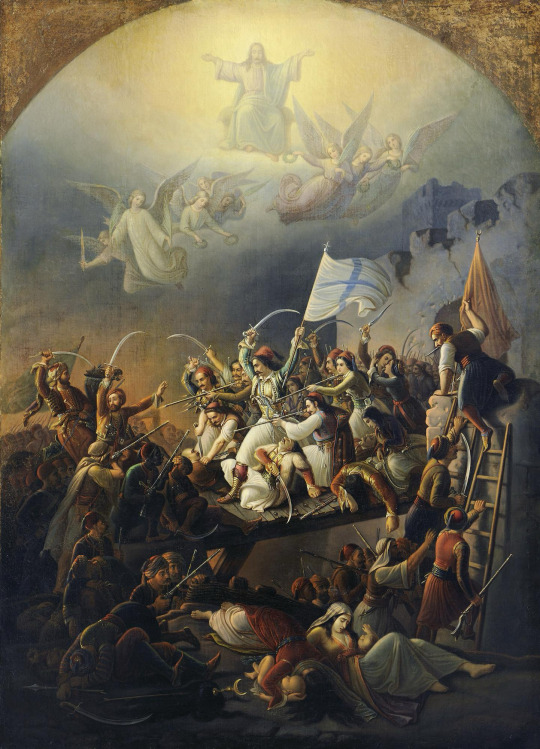
Vryzakis Theodoros, The Exodus from Missolonghi, 1853. National Gallery, Athens.
The Munich School (19th century Academic Realism)
After centuries of Ottoman rule, few opportunities for an education in the arts existed in the newly independent Greece, so studying abroad was imperative for artists. The most important artistic movement of Greek art in the 19th century was academic realism, often called in Greece "the Munich School" because of the strong influence from the Royal Academy of Fine Arts of Munich where many Greek artists trained. In academic realism the imperative is the ethography, the representation of urban and/or rural life with a special attention in the depiction of architectural elements, the traditional cloth and the various objects. Munich School painters were specialized on portraiture, landscape painting and still life. The Munich school is characterized by a naturalistic style and dark chiaroscuro. Meanwhile, at the time we observe the emergence of Greek neoclassicism and naturalism in sculpture.

Nikolaos Gyzis, Learning by heart, 1883.
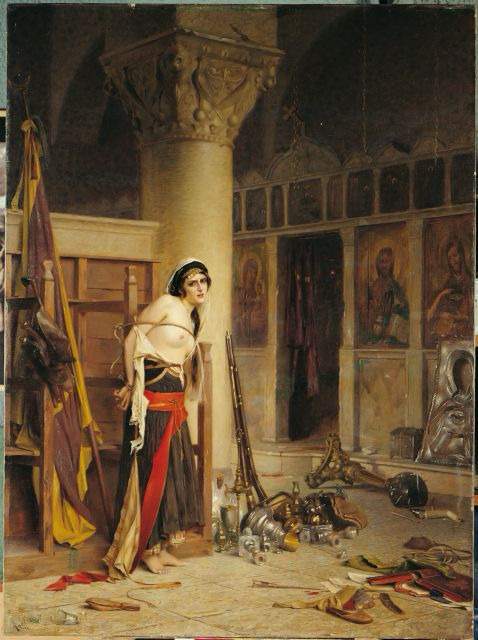
Rallis Theodoros, The Booty, before 1906.
20th Century Modern & Contemporary Greek Art
At the beginning of the 20th century the interest of painters turned toward the study of light and color. Gradually the impressionists and other modern schools increased their influence. The interest of Greek painters, artists changes from historical representations to Greek landscapes with an emphasis on light and colours so abundant in Greece. Representatives of this artistic change introduce historical, religious and mythological elements that allow the classification of Greek painting into modern art. The era of the 1930s was a landmark for the Greek painters. The second half of the 20th century has seen a range of acclaimed Greek artists too serving the movements of surrealism, metaphysical art, kinetic art, Arte Povera, abstract excessionism and kinetic sculpture.
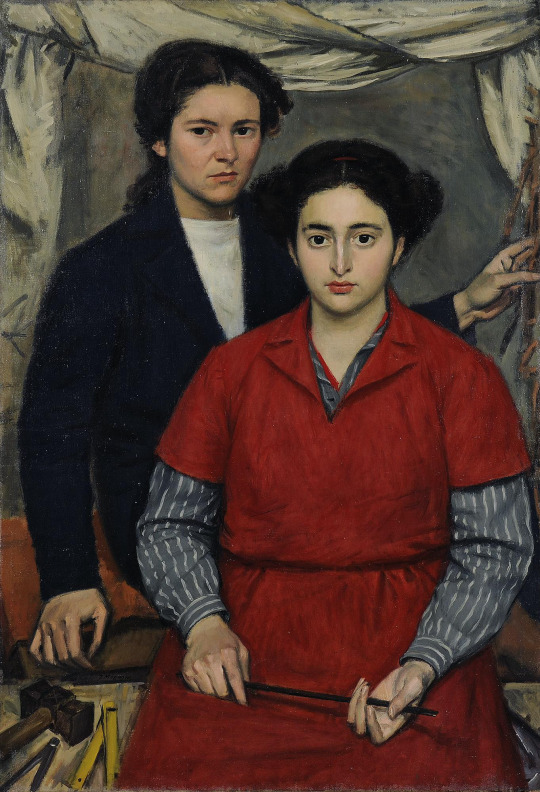
Yiannis Moralis, Two friends, 1946.
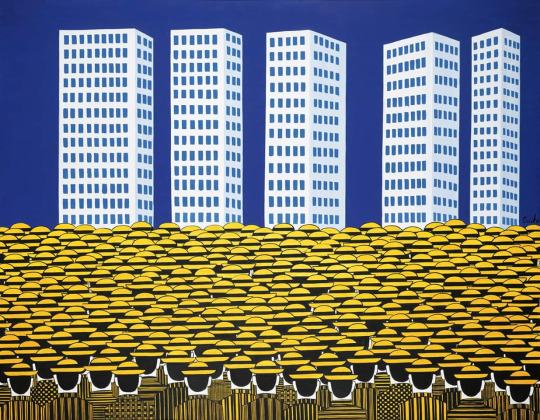
Art by Giannis Gaitis (1923-1984), famous for his uniformed little men.

By Yorghos Stathopoulos (1944 - )
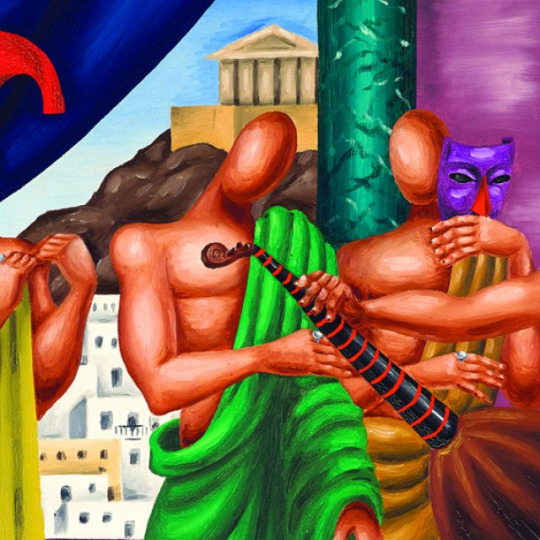
Art (detail) by Nikos Engonopoulos (1907 - 1985)
Folk, Modern Ecclesiastical and Secular Post-Byzantine Art
Ecclesiastical art, church architecture, holy painting and hymnology follow the order of Greek Byzantine tradition intact. Byzantine influence also remained pivotal in folk and secular art and it currently seems to enjoy a rise in national and international interest about it.

A modern depiction of the legendary hero Digenes Akritas depicted in the style of a Byzantine icon by Greek artist Dimitrios Skourtelis. Credit: Dimitrios Skourtelis / Reddit

Erotokritos and Aretousa by folk artist Theophilos (1870-1934)

Example of Modern Greek Orthodox murals, Church of St. Nicholas.

Ancient Greek philosophers depicted in iconographic fashion in one of Meteora’s monasteries. Each is holding a quote from his work that seems to foreshadow Christ. Shown from left to right are: Homer, Thucydides, Aristotle, Plato and Plutarch. This is not as weird as it may initially seem: it was a recurrent belief throughout the history of Christian Greek Orthodoxy that the great philosophers of the world heralded Jesus' birth in their writings - it was part of the eras of biggest reconciliation between Greek Byzantinism and Classicism.

Prophet Elijah icon with Chariot of Fire, Handmade Greek Orthodox icon, unknown iconographer. Source
If you see this, thanks very much for reading this post. Hope you enjoyed!
#greece#art#europe#history#culture#greek art#artists#greek culture#history of art#classical art#ancient greek art#byzantine greek art#christian art#orthodox art#modern art#modern greek art#anon#ask
65 notes
·
View notes
Text







Tokuriki Tomikichiro (1902 - 2000) was a modern Japanese woodblock printmaker. He represented the 12th generation of a Kyoto artisan family designated as the official Kyoto print artists for the famous Honganji Temple. He graduated from Kyoto City School of Fine Arts and Kyoto City Specialist School of Painting in 1924. After World War II, he established the Matsukyu Publishing Company to produce and distribute his own prints and other Shin Hanga and Sosaku Hanga pieces. Tomikichiro Tokuriki was an influential figure in Japan's contemporary print movement. He was the official artist of the Honganji Temple, and his work has been commissioned for various temples throughout Japan, including the famous shrines at Ise. His prints are in the permanent collections of the Museum Fine Arts Boston and the Museum of Modern Art New York.
The reverence for sakura in Japan runs deep. Cherry blossoms bloom fleetingly in spring, eventually falling from the tree’s branches, and are replaced with the green leaves of summer. To see the cherry blossoms in bloom is to experience a moment that is temporary. Mono no aware, which means “the pathos of things,” is a Japanese phrase that attempts to encapsulate the nature of this kind of impermanence—of things that don’t stay forever. Sakura, or cherry blossoms, is the symbol of this phenomenon. In celebration of spring, sakura, and the brevity of such a season, we’ve curated a selection of cherry blossom paintings and other Japanese arts and crafts that commemorate just that.
14 notes
·
View notes
Text

pablo reinoso in against the grain: wood in contemporary art, craft + design - museum of arts and design (2012)
444 notes
·
View notes